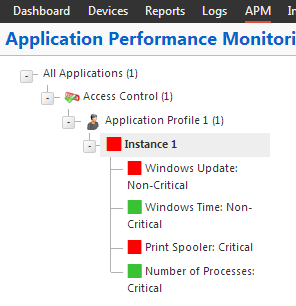Learning about APM component's instance state precedence
The overall application instance state (Up, Down, Warning, Unknown, or Maintenance) is determined by the state of the components within the instance. The following are the instance state levels of precedence, with level 1 in the table below being the highest state priority and level 8 being the lowest state priority.
APM Instance State |
APM Instance State Priority (precedence) |
APM Maintenance component. The Maintenance state indicates that the instance level monitor has been placed into a Maintenance state. |
1 |
Down state critical component. A Down state for a critical component indicates that one or more of an application's critical components, component groups or applications has exceeded its down threshold. If a critical component is in the Down state, the instance goes into the Down state or a state with higher precedence. |
2 |
Warning state critical component. The Warning state for a critical component indicates that one or more critical components or applications has entered the Warning state. If a critical component is in the Warning state, the instance goes into the Warning state or a state with higher precedence. |
3 |
Unknown state critical component. The Unknown state for a critical component indicates that the state of a critical component or application cannot be determined. If a critical component is in the Unknown state, the instance goes into the Unknown state or a state with higher precedence. |
4 |
Down state component. The Down state for a component indicates that one or more of an application's non-critical components, component groups or applications has exceeded its down threshold. If a component is in the Down state, the component's instance will be in a state determined by the highest level of state precedence of all of the components. |
5 |
Warning state component. The Warning state for a component indicates that one or more non-critical components or applications have entered the Warning state. If a component is in the Warning state, the component's instance will be in the Warning state determined by the highest level of state precedence of all of the components. |
6 |
Up / Critical Up state component. The Up state for a component indicates that one of the monitored components, critical component groups and applications that are defined in the application instance are in the Up state. If a component or critical component is in the Up state, the component's instance will be in a state determined by the highest level of state precedence of all of the components. |
7 |
Unknown state component. The Unknown state for a component indicates that the state of the component or application cannot be determined. If a component is in the Unknown state, the component's instance will be in a state determined by the highest level of state precedence of all of the components. |
8 |
Examples of APM component's instance state precedence:
APM Component states |
Resulting APM Instance state |
All components, critical and non-critical in Application Profile 1, are in an Up state, therefore the instance (Instance 1) is in an Up state. |
|
Print Spooler (critical component in Unknown state) takes precedence over Windows Update (non-critical component in Down state), therefore the instance (Instance 1) is in an Unknown state. |
|
Windows Update (non-critical component in Down state), with all other components in Up state, therefore the instance (Instance 1) is in a Warning state. |
|
Print Spooler (critical component in Down state) takes precedence over Windows Update (non-critical component in Down state), therefore the instance (Instance 1) is in a Down state. |
|
Instance 1 (instance) is placed in Maintenance mode, therefore all components within this instance are placed in Maintenance mode.
|
|
For more information, see Working with application states.




